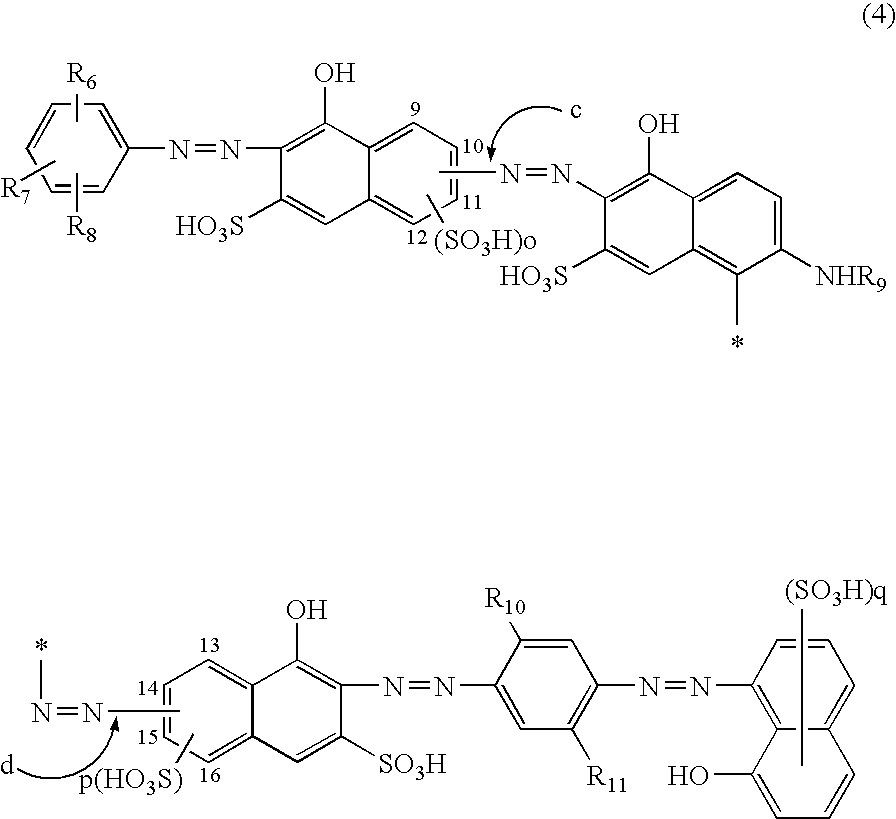Water-base black ink composition and colored product
a technology of black ink and water-base, which is applied in the direction of organic dyes, polyazo dyes, organic chemistry, etc., can solve the problems of insufficient performance, technical barriers, and affect image quality,
- Summary
- Abstract
- Description
- Claims
- Application Information
AI Technical Summary
Benefits of technology
Problems solved by technology
Method used
Image
Examples
example 1-1
[0194]Into 200 parts of water, 20.42 parts of a compound of Formula (111) as shown below was dissolved while adjusting pH at 5.5 to 8.0 with sodium hydroxide. Next, temperature of said solution was set to 5 to 10° C., and a diazo reaction was conducted by the addition of 52.2 parts of a 35% hydrochloric acid solution and 28.0 parts of a 40% aqueous solution of sodium nitrite thereto.
[0195]
[0196]This diazo suspension was added dropwise into an aqueous alkaline solution containing 24.7 parts of 7-amino-1-hydroxynaphthalene-3-sulfonic acid in 200 parts of water at 15 to 30° C. During the dropwise addition, pH value of the solution was retained at 8.5 to 9.5 with sodium carbonate. After the end of the dropwise addition, further stirring was conducted for 3 hours at pH of 8.5 to 9.5, at 15 to 30° C., to complete a coupling reaction and to obtain a reaction solution containing a compound of Formula (112) as shown below. Thereafter, salting out thereof was conducted by the addition of sodi...
example 1-2
[0205]The same method as in Example 1-1 was conducted except that 42.0 parts of 7-amino-1-hydroxynaphthalene-3,6-disulfonic acid was used instead of 24.7 parts of 7-amino-1-hydroxynaphthalene-3-sulfonic acid of Example 1-1, to obtain 20.2 parts of an azo compound of Formula (121) as shown below (a compound of No. 2-2 in Table 3). The maximum absorption wavelength in water of this compound was 657 nm, and solubility in water was 100 g / l or more.
[0206]
example 1-3
[0207]The same method as in Example 1-1 was conducted except that 17.86 parts of 1-amino-2-benzenesulfonic acid was used instead of 20.42 parts of the compound of Formula (111) of Example 1-1, to obtain 18.2 parts of an azo compound of Formula (131) as shown below (a compound of No. 2-3 in Table 3). The maximum absorption wavelength in water of this compound was 650 nm, and solubility in water was 100 g / l or more.
[0208]
PUM
| Property | Measurement | Unit |
|---|---|---|
| absorption wavelength | aaaaa | aaaaa |
| pH | aaaaa | aaaaa |
| pH | aaaaa | aaaaa |
Abstract
Description
Claims
Application Information
 Login to View More
Login to View More - R&D
- Intellectual Property
- Life Sciences
- Materials
- Tech Scout
- Unparalleled Data Quality
- Higher Quality Content
- 60% Fewer Hallucinations
Browse by: Latest US Patents, China's latest patents, Technical Efficacy Thesaurus, Application Domain, Technology Topic, Popular Technical Reports.
© 2025 PatSnap. All rights reserved.Legal|Privacy policy|Modern Slavery Act Transparency Statement|Sitemap|About US| Contact US: help@patsnap.com



